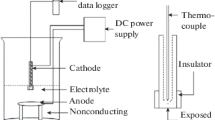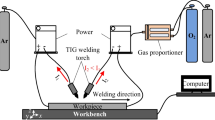Abstract
Arc welds in titanium typically exhibit thin strips of blue interference colours parallel to the welds. These features can cause difficulty in meeting conventional colour acceptance criteria, even though the fused zone may be silver. They have been called “tramlines” or “rail tracks” and develop within the shielded area, largely irrespective of the integrity of the shielding. In keyhole plasma welds, the “tramlines” are far broader than for tungsten inert gas welds, presenting a better opportunity to study their formation. Experimental evidence showed that the tramlines consisted of an oxide scale, significantly thicker than surface oxides on either the as-received parent metal surface or the silver metal between the tramlines and the weld metal. The formation of tramlines parallel to titanium weldments, within a properly gas-shielded area, is a consequence of surface condition, rather than an effect of the local environment during the welding operation. Since the heat-affected zone tramlines are very thin, colour criteria for weld acceptance should allow for the formation of these features in many applications.



















Similar content being viewed by others
References
Smith LS, Gittos MF (1998) "Hydrogen induced porosity and hydride cracking in titanium alloys", TWI Members’ Report 7321.02/98
Mitchel DR (1965) Porosity in titanium welds. Weld J 44(4):57s–167s
Smith LS, Gittos MF (1998) "High Productivity Welding Ti-6Al-4V alloys", TWI Members’ Report, 7321.01/98
Hickman JW, Gulbransen EA (1948) Analyt Chem 20:158
Gittos MF, Scott MH, Nicholson RJK (1992) "Effect of contamination by air on the TIG welding of commercially pure titanium sheet", Titanium ’92 Science and Technology, San Diego California, June 1992
Greenwood NN, Earnshaw A (1984) "Chemistry of the elements", Pergamon Press, Oxford, p 1118–1119
Kubaschewski O, Hopkins BE (1953) Oxidation of metals and alloys. Butterworths (Publishers), London, pp 207–213
Acknowledgements
The authors gratefully acknowledge the many people who have aided the progress of this work. The authors are indebted to John Schley and RMI Titanium for the provision of the pipe and consumables, Chris Hardy for his dedication to the welding trials, Bill Lucas, the late Trevor Gooch and many others, including Bryan Benn and Michael Kennard of Rolls-Royce, for useful technical advice. Thanks are also owed to Mike Holt at the Interface Analysis Centre at Bristol University for performing the Auger analyses. This work was funded by the Industrial Members of TWI, as part of the Core Research Programme.
Author information
Authors and Affiliations
Corresponding author
Additional information
Doc. IIW-2421, recommended for publication by Commission IX "Behaviour of Metals Subjected to Welding".
L.S. Smith formerly TWI Ltd
Rights and permissions
About this article
Cite this article
Smith, L.S., Gittos, M.F. Formation of thin bands of interference colours or “tramlines” adjacent to arc welds in titanium and its alloys. Weld World 58, 127–142 (2014). https://doi.org/10.1007/s40194-013-0105-8
Received:
Accepted:
Published:
Issue Date:
DOI: https://doi.org/10.1007/s40194-013-0105-8




